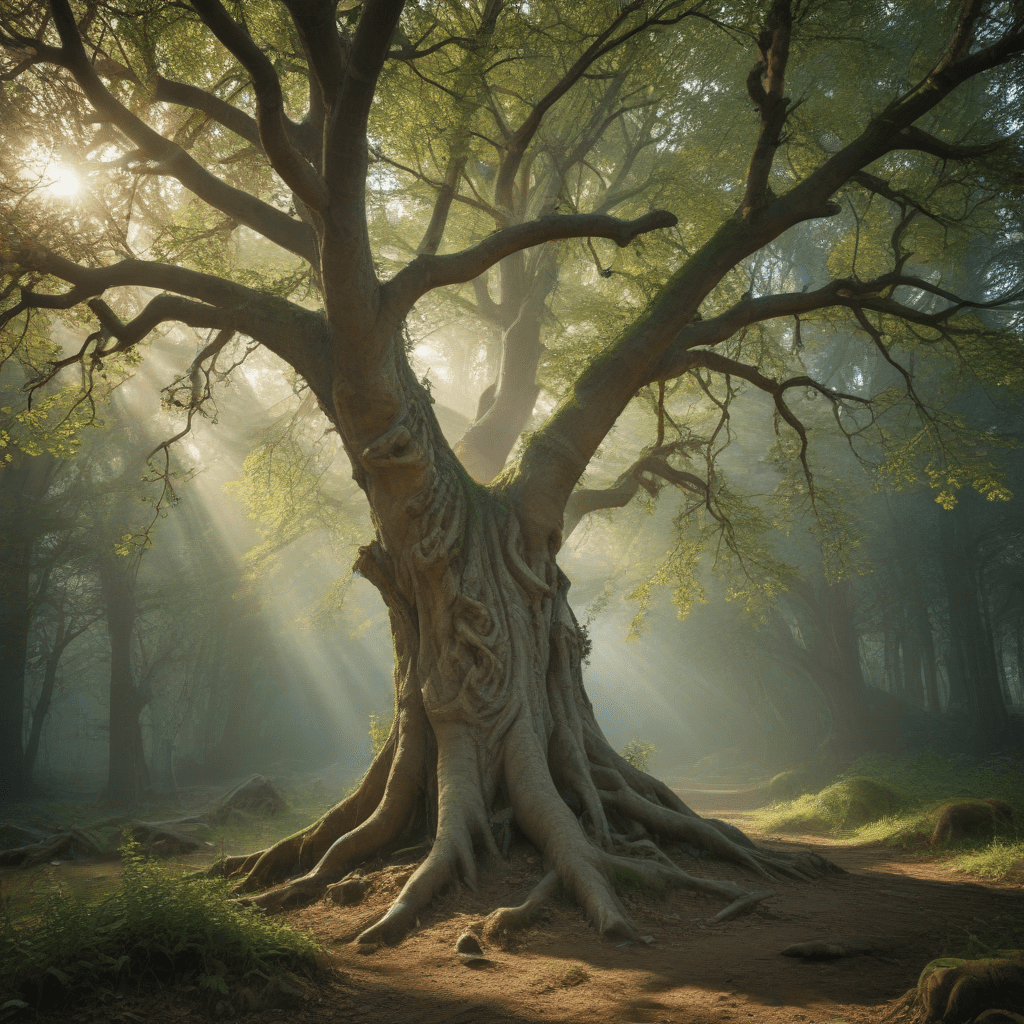The Symbolism of Trees in Slavic Mythology
Trees hold profound significance in Slavic mythology, embodying a wide range of meanings and serving vital roles in the lives of ancient Slavs. Their towering presence and enduring cycles have inspired a rich tapestry of beliefs, rituals, and folklore surrounding their sacred and symbolic qualities.
1. The World Tree
Central to Slavic mythology is the concept of the World Tree, a vast and mystical tree that connects the heavens, the earth, and the underworld. This tree, often depicted as an oak or a birch, serves as a cosmic axis and a symbol of life, order, and the interconnectedness of all things. The World Tree is believed to hold the celestial bodies, regulate the seasons, and provide sustenance to the world.
2. Sacred Groves and Trees
Ancient Slavs revered sacred groves and individual trees, believing them to be imbued with divine power and inhabited by spirits. These groves, often located in secluded forests or on hills, were considered sanctuaries where religious ceremonies and rituals were performed. Certain trees, such as oaks, ashes, and lindens, were particularly esteemed and were believed to house ancestral spirits, deities, or otherworldly beings. Offerings and prayers were made to these trees, seeking guidance, protection, and blessings.
3. Tree Deities and Spirits
Slavic mythology includes a pantheon of deities and spirits associated with trees. The goddess Marena, for example, is connected to the birch tree and is said to represent springtime renewal and fertility. The spirit Leshy, the guardian of the forest, is often depicted as a tree-like creature with a green beard and a fondness for playing tricks on humans. These figures embody the belief that trees possess consciousness, agency, and a deep connection to the natural world.
6. Trees in Healing and Magic
Slavs believed that trees possessed healing properties and played a significant role in traditional medicine. Certain trees, such as willows, were associated with healing, while others, like rowans, were used to ward off evil and protect against curses. Bark, leaves, and other parts of trees were used to create medicinal remedies for treating various ailments. Additionally, trees were used in magical practices, such as divination, prophecy, and the creation of protective charms.
7. Trees in Folklore and Legends
Trees feature prominently in Slavic folklore and legends, embodying wisdom, guidance, and the connection between humans and the natural world. The motif of a talking tree, offering advice or assistance, is common in folk tales. Trees are also associated with the supernatural, serving as dwelling places for fairies, witches, and other mythical beings. Slavic epics often recount stories of heroes seeking wisdom or shelter beneath ancient trees.
8. Trees and the Underworld
In Slavic mythology, trees are closely linked to the underworld and the realm of the dead. Certain trees, such as the cypress, were believed to mark the entrance to the underworld. Souls of the departed were said to dwell within trees, and their spirits could communicate with the living through rustling leaves or tapping branches. Trees were also used in funerary rites, with coffins being carved from tree trunks and branches being placed on graves as symbols of remembrance and connection to the afterlife.
9. Trees and the Divine
Trees are deeply connected to the divine in Slavic mythology. They are considered sacred beings, venerated as intermediaries between humans and the gods. Offerings were made to trees as a way of honoring the deities and seeking their protection. Certain trees were believed to be the dwelling places of particular gods or goddesses, and religious rituals were often performed beneath their canopies. Trees were also seen as symbols of fertility, abundance, and prosperity, representing the divine blessings bestowed upon the land.
10. Contemporary Symbolism of Trees in Slavic Culture
While ancient Slavic beliefs have evolved over time, the symbolism of trees remains a vibrant part of Slavic culture today. Trees continue to be revered as symbols of life, nature, and interconnectedness. They are featured in traditional crafts, such as wood carvings and embroidery, and are often incorporated into festivals and celebrations. The planting and care of trees is considered an honorable act, reflecting the deep-rooted connection between Slavic people and the natural world.
FAQ
Q: What is the significance of the World Tree in Slavic mythology?
A: The World Tree is a central symbol representing the connection between the heavens, earth, and underworld. It embodies life, order, and the interconnectedness of all things.
Q: How did ancient Slavs use trees in their religious practices?
A: Trees were revered as sacred groves and individual trees, believed to be inhabited by spirits and deities. Offerings and prayers were made to trees for guidance, protection, and blessings.
Q: Do trees play a role in Slavic folklore and legends?
A: Yes, trees feature prominently in Slavic folklore and legends, embodying wisdom, guidance, and the connection between humans and the natural world. They are often associated with talking trees, fairies, witches, and other mythical beings.
Q: How are trees connected to the divine in Slavic mythology?
A: Trees are considered sacred beings, venerated as intermediaries between humans and the gods. Certain trees were believed to be dwelling places of particular deities, and offerings were made beneath their canopies as a way of honoring the gods.
Q: How is the symbolism of trees reflected in contemporary Slavic culture?
A: Trees remain revered in Slavic culture today as symbols of life, nature, and interconnectedness. They are featured in traditional crafts, festivals, and celebrations, and the planting and care of trees is considered an honorable act.



